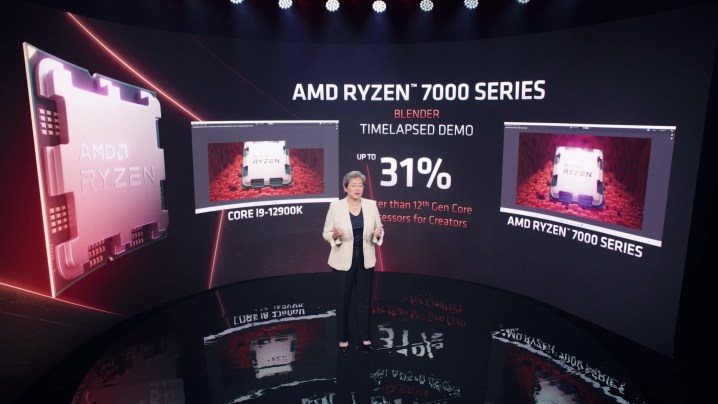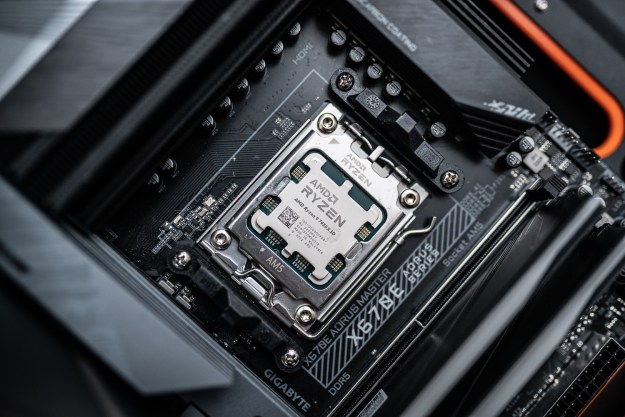AMD officially announced its Ryzen 7000 processors at Computex 2022. The chips are built on the new Zen 4 architecture, which AMD says is up to 31% faster than the best Intel processors in certain applications. Details are light for now, but AMD says the new range will be available this fall.
We didn’t get any specs or model names at Computex, but AMD still showed off its flagship 16-core chip rendering an image in Blender 31% faster than Intel’s Core i9-12900K. The company dipped its toes in gaming, as well, showing a pre-production 16-core chip running Ghostwire Tokyo while boosting around 5.5GHz. That’s without overclocking, as well.

Although AMD didn’t share explicit specs, the company says Ryzen 7000 CPUs use a chiplet design that houses two Zen 4 chiplets, each with up to eight Zen 4 cores. That means the flagship chip will come with 16 cores, the same number as the Ryzen 9 5950X. Instead of core count, AMD is stressing clock speed as the defining spec of this next generation.
AMD CEO Lisa Su said that Ryzen 7000 will be capable of clock speeds “significantly” above 5GHz. We only have the 5.5GHz speed in Ghostwire Tokyo to reference for now, but AMD has previously referenced the overclocking potential and clock speed limits of Ryzen 7000.
In addition to clock speed, which AMD says is bolstered by a generational improvement of more than 15% in single-threaded performance, Ryzen 7000 CPUs come with double the amount of L2 cache as Ryzen 5000. AMD didn’t mention if the new chips will support 3D V-Cache as the Ryzen 7 5800X3D does, however.
Part of the reason there are only 16 cores is to make room for a dedicated I/O die on the processor, which performs double duty. First, it houses RDNA 2 graphics on Ryzen 7000 processors. Finally, AMD’s Ryzen range will have integrated graphics. Ryzen 7000 graphics aren’t built for gaming, though, instead focusing on troubleshooting and mainstream customers.

The I/O die also enables a slew of connectivity options for the new AM5 platform. We’ve known for a while that AMD is retiring its AM4 platform that launched with first-gen Ryzen, but this was our first official look at the upcoming socket. AM5 motherboards support 24 lanes of PCIe 5.0, up to 14 USB ports with 20Gbps speeds, and four independent display outputs (either HDMI 2.1 or DisplayPort 2), which is all enabled by the I/O die.
In addition, AM5 supports DDR5 to compete with Intel’s Alder Lake platform. As previous rumors suggested, however, AM5 motherboards exclusively use DDR5. This is a different approach than Intel Alder Lake took, which supports both DDR5 and DDR4.
The AM5 socket takes some other notes from Intel with an LGA socket, which puts the pins on the motherboard instead of on the CPU (as PGA sockets do). That cloud bloat the cost of AM5 motherboards, as we’ve traditionally seen with Intel platforms.

A new socket means a new chipset, and AMD has some changes on that front, as well. In addition to X670 and B650 chipsets, the company is launching the new X670E chipset. This chipset is built for extreme overclocking scenarios, according to AMD, and comes with PCIe 5.0 support across all storage and graphics slots.
The cheaper X670 and B650 options still support overclocking, but they limit PCIe 5.0 access. X670 supports at least one PCIe 5.0 NVMe slot as well as optional PCIe 5.0 graphics, while B650 cuts PCIe 5.0 graphics entirely. The company originally announced the boards would support up to 170W of power, but AMD clarified that Ryzen 7000 can go up to 230W.
Several vendors have already announced X670 motherboards at Computex.
Ryzen 7000 is due out this fall, so hopefully, we’ll hear more about specs, prices, and the release date in the coming months. In the meantime, make sure to check out all the announcements from AMD’s Computex keynote.
Editors' Recommendations
- AMD’s new Ryzen 8040 CPUs aren’t all that new
- AMD isn’t competing with Intel anymore — Threadripper just wins
- AMD’s upcoming Ryzen 5 5600X3D could completely dethrone Intel in budget builds
- Some Ryzen CPUs are burning up. Here’s what you can do to save yours
- Between AMD’s Ryzen 7 7800X3D and Ryzen 9 7950X3D, there’s no contest





